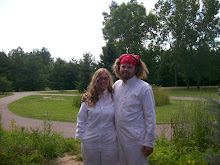


This is some of the progress we've had in one of our hybrid hives. For this particular hive, we got it as a nucleus hive from our supplier, Turtle Bee Honey Tree Farms. A nucleus hive is an established colony, usually with four to five combs drawn out with some brood and nectar. A standard Lang box will house ten frames, so we chose to use top bars in place of filling the rest of the box with frames. For a nucleus hive, the body that will house the brood, or baby bees, will be a deep super. This is just a natural step, followed by many beekeepers to give the bees their biggest house for maximum brood rearing. When it came time to add another super (another box) we opted to go with all top bars in their honey super.
This is some of the above progress. Notice that they still build the comb perfectly straight, as if it were in a frame? Without the foundation or the sides and bottoms to the frame, the bees are left to decide the perfect size for the cell. The bees do not naturally need to attach the comb to the side, but often use the sides as a bridge, because we as the beekeeper are obtrusive and our continuous opening of the hive causes them to need extra support. One thing we've become familiar with, is how to handle the top bars. Obviously they can can tear or crush from their own weight if you do not handle them with care. The shape of honey comb is naturally designed to be strong, durable, and handle the vast weight the bee's carry (Half of their body weight of nectar or pollen is not unusual!!) but there are natural ways the comb lie that will reinforce the cells integrity. Notice how Keith handles the comb by flipping it over end to end? That keeps the cell structure at its maximum, as well as uses centrifugal force to keep the nectar that is not yet capped honey from spilling from the cells. Fascinating huh? Who would have thought that mathematics, physics, woodworking, and agriculture could convalescence into such a perfect craft?!
We are preparing ourselves for winter and getting our strategy ready to get lots of work done over the winter so we can have happy bees come spring time!! Happy beekeeping!





No comments:
Post a Comment